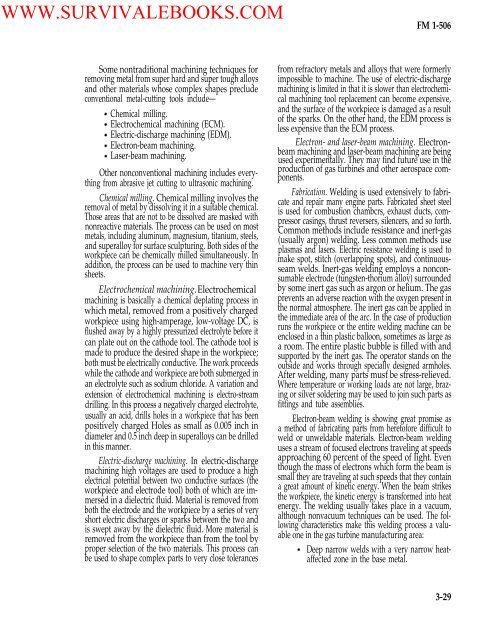FM 1-506 Fundamentals of Aircraft Power Plants ... - Survival Books
FM 1-506 Fundamentals of Aircraft Power Plants ... - Survival Books
FM 1-506 Fundamentals of Aircraft Power Plants ... - Survival Books
You also want an ePaper? Increase the reach of your titles
YUMPU automatically turns print PDFs into web optimized ePapers that Google loves.
WWW.SURVIVALEBOOKS.COM<strong>FM</strong> 1-<strong>506</strong>Some nontraditional machining techniques forremoving metal from super hard and super tough alloysand other materials whose complex shapes precludeconventional metal-cutting tools include—Chemical milling.Electrochemical machining (ECM).Electric-discharge machining (EDM).Electron-beam machining.Laser-beam machining.Other nonconventional machining includes everythingfrom abrasive jet cutting to ultrasonic machining.Chemical milling. Chemical milling involves theremoval <strong>of</strong> metal by dissolving it in a suitable chemical.Those areas that are not to be dissolved are masked withnonreactive materials. The process can be used on mostmetals, including aluminum, magnesium, titanium, steels,and superalloy for surface sculpturing. Both sides <strong>of</strong> theworkpiece can be chemically milled simultaneously. Inaddition, the process can be used to machine very thinsheets.Electrochemical machining.Electrochemicalmachining is basically a chemical deplating process inwhich metal, removed from a positively chargedworkpiece using high-amperage, low-voltage DC, isflushed away by a highly pressurized electrolyte before itcan plate out on the cathode tool. The cathode tool ismade to produce the desired shape in the workpiece;both must be electrically conductive. The work proceedswhile the cathode and workpiece are both submerged inan electrolyte such as sodium chloride. A variation andextension <strong>of</strong> electrochemical machining is electro-streamdrilling. In this process a negatively charged electrolyte,usually an acid, drills holes in a workpiece that has beenpositively charged Holes as small as 0.005 inch indiameter and 0.5 inch deep in superalloys can be drilledin this manner.Electric-discharge machining. In electric-dischargemachining high voltages are used to produce a highelectrical potential between two conductive surfaces (theworkpiece and electrode tool) both <strong>of</strong> which are immersedin a dielectric fluid. Material is removed fromboth the electrode and the workpiece by a series <strong>of</strong> veryshort electric discharges or sparks between the two andis swept away by the dielectric fluid. More material isremoved from the workpiece than from the tool byproper selection <strong>of</strong> the two materials. This process canbe used to shape complex parts to very close tolerancesfrom refractory metals and alloys that were formerlyimpossible to machine. The use <strong>of</strong> electric-dischargemachining is limited in that it is slower than electrochemicalmachining tool replacement can become expensive,and the surface <strong>of</strong> the workpiece is damaged as a result<strong>of</strong> the sparks. On the other hand, the EDM process isless expensive than the ECM process.Electron- and laser-beam machining. Electronbeammachining and laser-beam machining are beingused experimentally. They may find future use in theproduction <strong>of</strong> gas turbines and other aerospace components.Fabrication. Welding is used extensively to fabricateand repair many engine parts. Fabricated sheet steelis used for combustion chambcrs, exhaust ducts, compressorcasings, thrust reversers, silencers, and so forth.Common methods include resistance and inert-gas(usually argon) welding. Less common methods useplasmas and lasers. Electric resistance welding is used tomake spot, stitch (overlapping spots), and continuousseamwelds. Inert-gas welding employs a nonconsumableelectrode (tungsten-thorium alloy) surroundedby some inert gas such as argon or helium. The gasprevents an adverse reaction with the oxygen present inthe normal atmosphere. The inert gas can be applied inthe immediate area <strong>of</strong> the arc. In the case <strong>of</strong> productionruns the workpiece or the entire welding machine can beenclosed in a thin plastic balloon, sometimes as large asa room. The entire plastic bubble is filled with andsupported by the inert gas. The operator stands on theoutside and works through specially designed armholes.After welding, many parts must be stress-relieved.Where temperature or working loads are not large, brazingor silver soldering may be used to join such parts asfittings and tube assemblies.Electron-beam welding is showing great promise asa method <strong>of</strong> fabricating parts from heret<strong>of</strong>ore difficult toweld or unweldable materials. Electron-beam weldinguses a stream <strong>of</strong> focused electrons traveling at speedsapproaching 60 percent <strong>of</strong> the speed <strong>of</strong> Iight. Eventhough the mass <strong>of</strong> electrons which form the beam issmall they are traveling at such speeds that they containa great amount <strong>of</strong> kinetic energy. When the beam strikesthe workpiece, the kinetic energy is transformed into heatenergy. The welding usually takes place in a vacuum,although nonvacuum techniques can be used. The followingcharacteristics make this welding process a valuableone in the gas turbine manufacturing area:Deep narrow welds with a very narrow heataffectedzone in the base metal.3-29
















